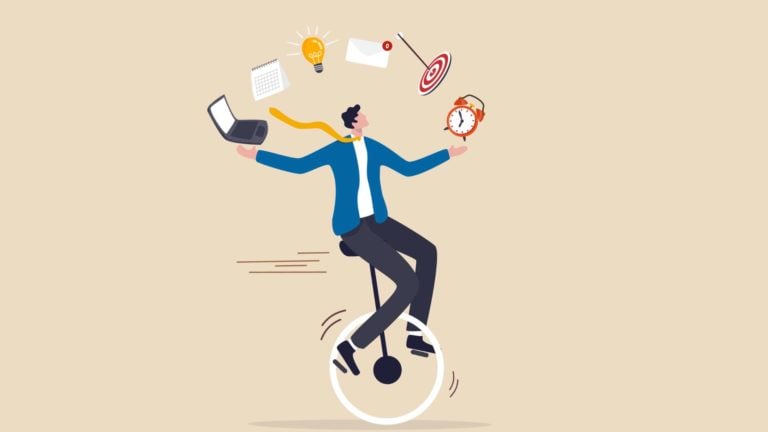Increasing workplace productivity helps to promote a strong company culture, increase employee happiness, and reduce employee turnover. Read on to learn our top seven tips for increasing workplace productivity.
While all employees aspire to achieve an efficient workflow, distractions to your team’s workday often hinder productivity. Your team’s work plans may be derailed by unplanned meetings, group chat messages, and unexpected tasks.
These distractions can have a significant impact on workplace productivity. As a manager, your team’s performance is directly linked to how you manage them and how effectively you prevent these distractions. Ensuring your team remains productive starts with you, so it’s important to give them the support and tools they need to be efficient and productive employees.
Concerned about striking the balance? Read on to learn about the benefits of having high workplace productivity and the top seven ways to increase it in your workplace.
What Is Workplace Productivity?
Workplace productivity is the efficiency with which you and your team complete workplace tasks. A more efficient team will complete their allocated work within a shorter time frame. Time that is freed up by more efficient processes can then be filled with other similar tasks or dedicated to new projects. This increase in output improves workplace productivity.
However, with increased productivity, it’s crucial to be mindful of work quality. Being productive is not about churning out a high volume of low-quality work. To increase productivity, your team needs to produce a good quantity of high-quality work. It’s important to effectively manage your team to maintain the same standard of work at a higher output.
The Difference Between Workplace Productivity and Workplace Efficiency
Efficiency and productivity in the workplace are similar concepts. However, in action, they are different.
Workplace productivity is the efficiency with which you and your team complete tasks. For example, a team of two people who can complete four tasks in one hour is more productive than a team of three who can complete the same tasks in two hours.
Workplace efficiency is how well a business uses its resources to complete tasks. For example, if three tasks are to be completed and three employees are allocated to the same task, this is not a good use of the team’s resources. However, if one employee is assigned to each task, this is a better example of workplace efficiency.
Advantages Of Productivity In The Workplace
Achieving high productivity in the workplace can have many advantages. These might include:
- An increase in profit. A more productive workforce will complete more of their allocated tasks in a shorter time frame. This will leave more time to take on new projects. This could lead to a higher company profit.
- Happier employees. When productivity is high, employees are more satisfied and feel a greater sense of purpose in the workplace. An article by Forbes states that overall, more productive employees feel happier at both work and home.
- Stronger company culture. Alongside employee happiness, a productive team will contribute to a strong company culture. Increased productivity will drive a feeling of team morale, creating a culture of hard work and positive well-being.
- Improved engagement. When employees feel more productive, they’re more likely to be involved in the company’s initiatives and activities. Taking part in these activities boosts employee engagement. A study by Gallup found that businesses with high employee engagement have 22% higher productivity than those with low employee engagement.
- Better employee retention. As stated above, increased productivity in the workplace leads to happier and more engaged employees. This will mean that employees are less likely to look for other jobs elsewhere, resulting in better employee retention. E. L. Goldberg & Associates estimate that replacing an employee could cost between 33% and 200% of an employee’s annual salary. Based on this, improving employee retention will benefit your bottom line.
Top 7 Ways To Increase Productivity In The Workplace
When increasing workplace productivity, it’s important to consider that all teams are different. Remember that what works for one team may not work for yours, so it’s essential to keep an open mind and be flexible when applying these tips!
Monotasking
Multitasking is often thought of as a way to increase output. However, monotasking is actually much more effective at increasing productivity. A Stanford study found that employees who multitask are more distractible and less efficient than those who monotask.
Monotasking is where you focus on one task at a time and don’t move on from that task until it is completed. While this may seem overwhelming, you can coach your team to break down large tasks into smaller, measurable goals.
When monotasking, it’s helpful to list the jobs you hope to complete in your workday. From this, break each job down into three or four smaller tasks, and focus on completing each task individually. Devote your full attention to each task until it is completed. If you are working to a deadline, you may find it helpful to delegate some of these tasks to your employees. Having multiple team members monotasking towards one common goal will boost your team’s productivity.
Work in short bursts
While increasing productivity will benefit your business in many ways, you shouldn’t push your employees too hard. Doing this might drive them to burnout which will hinder their productivity.
Try encouraging your team to work in short bursts and take regular breaks. Try working in short bursts of 20-25 minutes throughout the day. This should be followed by a 5-10 minute microbreak to maintain your team’s productivity.
Try talking to your team about their individual focusing capabilities. Some may be able to concentrate for longer periods than others. Equally, some neurodiverse employees may need more or longer microbreaks than other employees. Allowing neurodiverse employees to take extra breaks would qualify as a reasonable adjustment under the Americans with Disability Act (ADA). However, you’ll need to manage this sensitively to ensure individuals do not feel singled out or disadvantaged.
You could also use a productivity tool—such as a Pomodoro timer or other time-tracking device—to help your employees to be more productive. These can be especially helpful if your tasks require a high level of concentration and attention to detail.
Remove distractions
You must devote your full attention to the task at hand to improve productivity. Limiting distractions will help you achieve this.
Workplace distractions come in many forms, such as unnecessary group chats or your cell phone. Try muting or deleting group chats that do not feel relevant to your workday. You can also use Connecteam’s chat prioritization feature to hide irrelevant group chats and ‘favorite’ important ones. This is a great tool to help you prioritize your workload.
Another tip is to turn your cell phone off. This may be challenging if you need your cell phone for work or are expecting an important phone call. However, most cell phones now have “Do Not Disturb” functions, so only urgent queries come through.
Boost team productivity with Connecteam!
Limit unproductive meetings
Meetings can be a great way to collaborate with your teammates and get to the root cause of a problem. However, too many meetings can hinder productivity and lead to stress and burnout.
When trying to limit unproductive meetings, it’s important to consider whether you can add value to the content of the meeting. Scan the meeting agenda before responding to the invite, and if you can’t add value or don’t feel it’s relevant to your work, politely decline to attend where possible. If an agenda isn’t provided, be sure to ask for one.
If you cannot avoid a meeting, consider asking for a video meeting instead of a face-to-face meeting. Video meetings take less time and are more productive than face-to-face meetings. Conducting a video meeting will limit in-person distractions such as coffee breaks or non-work chats. This will allow you to return to your workflow faster. Video calls or meetings are especially useful for hybrid or remote workers.
You could also try setting a “meeting-free day” for your team or department. This will boost productivity by allowing distraction-free working time on set days or times of the week.
Find a good organizational system
A good organizational system for you and your team is vital when trying to boost productivity. You may find that a digital management system offers all the tools needed to operate a productive work day.
A strong digital management system will have built-in checklists and task tackers to help you delegate effectively and monitor workload. It may also have a built-in rota system so you can see who is available.
Connecteam offers all these tools and more. With a built-in task organizational system, easy delegation tools, and an integrated chat function to help you effectively communicate with your team, Connecteam is the perfect tool to organize your work day.
Utilise flexible working
Allowing work flexibility has become a key benefit in recent years. Kristin Kelly of CareerBuilder.com says, “Flexibility is the new norm and expectation from employees.”
Employees want to work where and when suits them best and not be tied down to a rigid nine-to-five working pattern. Allowing employees to work this way will boost productivity and create a strong workplace culture.
Allowing your team this benefit will limit workplace distractions, reduce your employees’ transport costs, and increase workplace productivity.
For example, a study by AirTasker found that the average office employee clocks in a total of 37 unproductive minutes per day, while the average remote worker clocks in 27 unproductive minutes per day. This small difference in unproductive minutes totals 36 hours of additional work per year.
Between their increased productivity and fewer workplace distractions, flexible employees work on average 1.4 more days every month than office employees. That’s almost 17 more days per year!
Don’t micromanage
Micromanagement is a negative term referring to when a manager observes employees and dictates to them how to do their jobs. While micromanagement can boost productivity in the short term, overall, it isn’t an effective management tool. Micromanagement reduces creativity, diminishes employee confidence, and, in extreme cases, increases employee turnover.
Most managers have been guilty of micromanaging at some point in their careers. While you may feel that you are an attentive manager, your team may feel they are being micromanaged, hindering productivity and detracting from workplace culture.
How do you strike a balance between supporting employees but not micromanaging them?
The best tool to fight micromanagement is trust; you need to trust that your employees will complete their tasks to a high standard and allow them autonomy wherever possible. Trust that if they need your support, they will ask for it. As a good manager, you should focus on the big picture and manage your team’s performance as a whole instead of managing how and when your individual employees complete tasks.
Conclusion
A more efficient team will complete their allocated work within a shorter time frame. The time saved by an efficient team allows for additional work to be completed which increases productivity. Increasing workplace productivity will contribute to a strong company culture and increase profits.
However, striking a balance between an effective workflow and limiting distractions can be tricky. As a manager, your team’s performance and productivity are directly linked to how effectively you manage their workload.
You can use many strategies to increase workplace productivity, including monotasking, taking regular breaks, and limiting workplace distractions. As a manager, you must focus on the big picture of how your team works instead of the day-to-day aspects of their roles. The best way to achieve this is by providing your employees with the right tools to succeed.
The right tools can boost productivity by helping you to minimize distractions, reduce unproductive meetings, and manage tasks effectively. All these tools and more are provided in software like Connecteam.



![image of [Free eBook] Building an Effective Internal Communication Strategy](https://connecteam.com/wp-content/uploads/2020/07/Scene-4-768x512.png)
